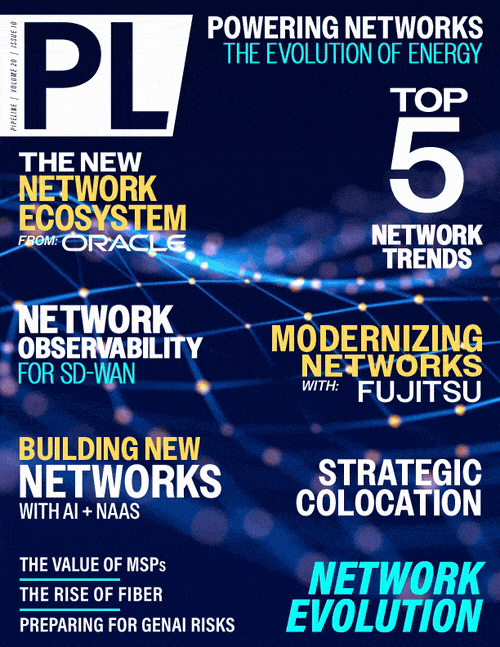Five Tech & Network Megatrends
That Will Shape the Future
Trend 2: The Expanding IoT and IIoT
Within the Device Layer, the Internet of Things (IoT) and Industrial IoT (IIoT) devices, integrated through intelligent gateways with built-in security and automation, are forming the backbone of the fully autonomous enterprise and opening doors for innovative use cases, providing continuous feedback loops across organizations and forming an operational foundation for AI decision-making and workflow and resource optimization.
Devices and sensor networks can sync with edge centers for low-latency data transfer and real-time analysis. In addition, AI oversight allows IoT systems to self-optimize, increasing on-the-floor efficiency with digital twins and predictive analytics. This applies as much to individual smart factories as it will to entire energy grids and smart cities.
IoT will also engender a much closer enterprise-consumer relationship. IoT home devices and wearables are already common, but the next decades will see transformative innovations in the human-computer interface and bio enhancement. Consider that the UK government has implicitly recognized Neil Harbisson as the world’s first cyborg, and Neuralink — essentially a creator of IoT devices — hopes to complete its first human trial by 2031.
The bio-integrated IoT devices that will underpin future developments in medical IoT constitute a particularly interesting case. As medical IoT advances, implanted devices will require a unique type of connectivity and data center management, with the possibility of specialized networks for augmented humans. What happens, for example, if somebody’s insulin pump or pacemaker gets hacked? Security literally becomes a matter of life and death.
The innovation stack creates the foundation for mass adoption by equipping enterprises with the tools and infrastructure they need to cater to complex IoT requirements. Equally important is the fact that enterprises will ultimately be responsible for the safety and management of sensitive data, which itself represents a significant technical undertaking.Trend 3: Massive, Instant, and Ubiquitous Connectivity
Within the Connectivity Layer, the emergence of an always-connected, autonomous, and robotic society demands unparalleled bandwidth and instant, ubiquitous connectivity — universal in the sense that it’s both global and extraterrestrial. While there are obstacles to a universal network, some of them governmental and some related to financial viability, ubiquitous connectivity looms as an imminent reality.
LEO constellations will supplement terrestrial networks to deliver high-speed broadband to remote areas at ever-increasing speeds, with non-terrestrial networks responsible for mission-critical connectivity. Low-latency lunar and Martian networks will also be key to remote space operations and scientific research.
NASA’s Artemis program is perhaps the best-known initiative to establish a base on the moon, but there are others, like the International Lunar Research Station and the European Space Agency Moon Village. Some have postulated that China’s lunar ambitions may be the beginning of a new “space cold war” with the US.
There are several notable current examples of the move towards a ubiquitous network. For example, T-Mobile has partnered with Starlink to provide US-wide connectivity by combining SpaceX’s low Earth orbit satellites with T-Mobile’s 5G wireless network. In addition, AST SpaceMobile is connecting ordinary phones to satellites, and Commstar is exploring building lunar network to exploit IIoT mining and colonization opportunities on the moon.
Quantum computing and networking will play a central role in delivering instant, universal connectivity by making it possible to transfer information at superluminal speeds. IonQ already offers accessible quantum cloud computing with enhanced capacity for problem-solving, scale, and speed, and it recently announced its collaboration with the US Air Force. EPB and Qubitekk built the first commercial quantum network in the US in 2022 (see also: Commercializing Quantum) and the Quantum Internet Alliance is in the process of building a quantum internet prototype in Europe. IBM also has recently annouced the opening of it's quantum data center in Europe, and Deutsche Telekom has formed a consortium to build a quantum communications infrastructure project as the foundation for an European quantum communications network. Similarly, post-quantum cryptography (covered in the next issue of Pipeline) will render current encryption standards obsolete, and quantum key distribution will provide unbreakable encryption for sensitive data transmission. Which is paramount as Q-Day approaches, seemingly faster by each passing day.
Quantum teleportation is happening with increasing degrees of accuracy. In 2017, China beamed up a quantum state into orbit. Earlier this year, a team at the University of Science and Technology of China achieved a quantum teleportation fidelity (or accuracy) of around 90 percent using hybrid quantum entanglement. The shift from photons to protons is already well underway for the transfer of data, and perhaps matter, in the not-to-distant future.
Connectivity providers are uniquely positioned to take advantage of the quantum opportunity, using existing service packages and relationships to gradually open the door to this transformative technology for enterprises and innovative new use cases.
Trend 4: The Blending of the Virtual and Physical Worlds
At the Application Layer, Augmented and Virtual Reality (AR/VR) incorporated together as Extended Reality (XR) will continue to integrate smoothly with natural reality, driven by enterprise adoption in the initial stages. Mixed reality, in particular, is changing how people and businesses interact with the physical world, allowing for control, modification, and interaction of objects through a virtual interface.
“Mixed reality is the next natural evolution of the human-computer interface,” says Tom Cheesewright, a leading futurist and author of Future-Proof Your Business who spoke to Pipeline. “We complete that evolution when we allow machines to interact with us in the physical domain through mixed reality. It will enable the richest and most intuitive human-computer experiences we have ever known, until the brain-computer interface matures, at least.”



















